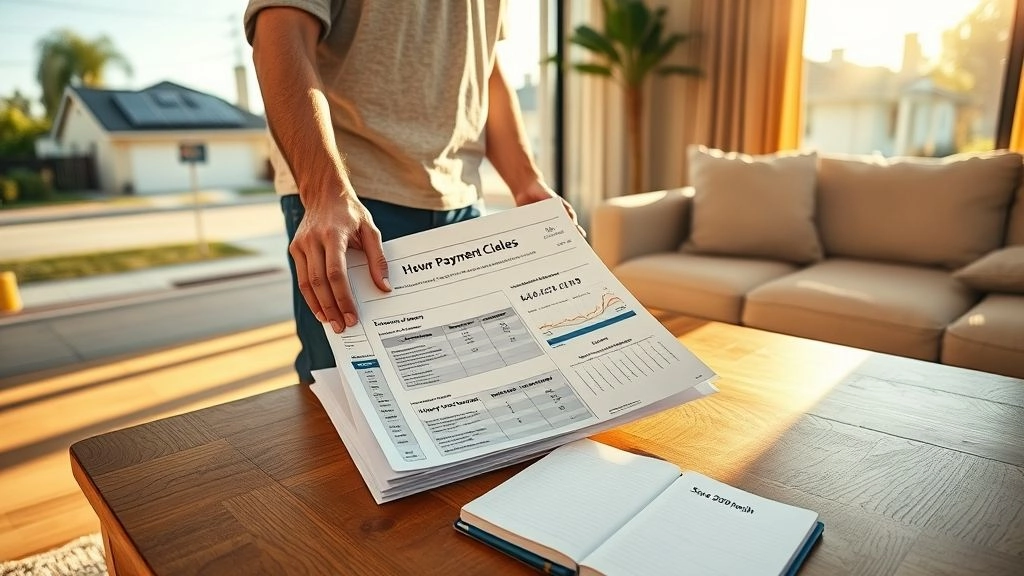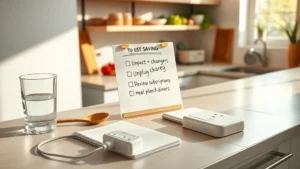Okay, let’s just admit it—dreaming about owning a house in California often feels like chasing a sunset that just won’t slow down. The prices are high, the competition fierce, and “saving enough” sounds like climbing a mountain barefoot. But what if I told you there’s a way to make those dollars add up, even in the Golden State? No magic tricks, just real, practical steps that someone like you and me can actually follow.
So yeah, maybe that daily latte or spontaneous online shopping isn’t your “down payment saboteur,” but have you ever noticed how those small, normal expenses quietly swallow up your savings potential? Let’s chat about how to stop that slow leak and start filling your house fund faster than you thought possible. Ready?
Set Your Goal
How Much Do You Actually Need?
First, let’s talk numbers—because dreams become plans when you get clear about the $$ involved. In California, down payments vary wildy. The median statewide down payment is around $84,000, but if you’re eyeing the Bay Area, prepare for a bite closer to $325,000. Meanwhile, in places like Riverside, that number can be more reasonable — like $38,000.
Whew. I know – these are big numbers. But here’s some good news: you don’t always need 20% down. Conventional loans here can require as little as 3% down, and FHA loans let you get started with just 3.5% if you qualify. Plus, if you’re a veteran, VA loans might not need any down payment at all. That’s a serious game changer.
Quick Breakdown of Down Payment Options
| Loan Type | Minimum Down Payment | Notes |
|---|---|---|
| Conventional | 3% | Depends on lender and borrower qualifications |
| FHA | 3.5% | Popular for first-time buyers |
| VA | 0% | For military members and veterans |
| USDA | 0% | For eligible rural buyers with income limits |
So first step—figure out your target down payment amount based on your budget and the area you want to live in. Use online tools or talk to a lender to get clear numbers.
Don’t Forget Closing Costs and Extras
Buying a home is not just about the down payment. Closing costs, inspections, and moving expenses will suck up another 2-5% of the home price, usually. That means if your down payment is $15,000 on a $500,000 home, you might need an additional $10,000 just to seal the deal. Ouch, right? But better to know now than get caught off guard.
Keep a Buffer for These
- Closing costs (2-5% of home price)
- Moving expenses
- Home inspections and appraisals
- First month’s utilities and homeowner’s insurance
It’s like giving yourself permission to breathe easier when the big day comes.
Use California Programs
Help is Closer Than You Think
Here’s a super hopeful note: California offers tons of assistance programs to make owning a home actually possible. The California Housing Finance Agency (CalHFA) runs down payment assistance and low-interest loans for first-time buyers.
The MyHome Assistance Program, for example, can cover up to 3.5% of your down payment or closing costs (that could be thousands saved!). Plus, local city and county programs sometimes provide even bigger aid, including grants that wipe out tens of thousands of dollars off your cash needs.
There’s also the Downpayment Toward Equity Act offering $25,000 grants for first-generation, first-time buyers who meet income limits. It’s like a secret weapon for folks who might otherwise feel priced out.
Am I Eligible?
Many of these programs require:
- Income under certain limits (often around 120%-180% of area median income)
- First-time buyer status (or no home ownership in last 3 years)
- Home purchase in eligible counties
- Completed homebuyer education program
If your household qualifies, these programs can jump start your savings efforts significantly. Don’t sleep on this—talk to a CalHFA-approved lender or your local housing authority to see what’s available.
Slash Your Expenses
Are You Bleeding Money Without Noticing?
Have you ever looked at your bank app and thought, “Wait, where did my paycheck go?” Spoiler: it’s probably those “little” expenses that feel harmless—daily coffees, takeaway dinners, subscriptions you forgot you even signed up for.
Cutting back doesn’t mean you have to live like a hermit, but trimming a few things can free up a couple hundred bucks a month. That adds up fast, especially when your goal is How to save money for a house in California.
Where to Start
| Expense | Monthly Spend | Frugal Swap | Possible Savings |
|---|---|---|---|
| Coffee runs | $120 | Home brewed coffee | $100 |
| Streaming subs | $50 | Drop unused services | $30 |
| Cab/Uber rides | $150 | Carpool or bike | $100+ |
Imagine redirecting $200, $300 a month into your house fund instead of leaks that barely register day to day.
California’s High Cost of Living
Yeah, utilities and gasoline can burn wallets here more than other places. But simple swaps—like energy-efficient bulbs, limiting air conditioning, or even getting a transit pass—can chip away at those costs.
I once swapped my usual grocery store for bulk bins plus discount markets in my neighborhood in SoCal. Ended up saving like $150 a month, which I threw straight into savings for a house. It doesn’t have to be perfect, just consistent.
Boost Your Income
Side Hustle Your Way Forward
If cutting spending is the diet, boosting income is the workout. Whether it’s freelancing, ridesharing, tutoring, or selling stuff you don’t need, busy Californians are making an extra $500–$1,000 a month hustling on the side.
Think about what skills you’ve got or hobbies you enjoy that can help you make a few bucks. Gardening? Landscaping gigs pay well in warmer suburbs. Writing? Sites like Upwork or Fiverr are gold mines if you can snag steady clients.
What Fits Your Life?
- Flexible hours versus fixed overtime
- Physical work versus desk jobs
- Side hustle with low start-up cost
Some people swear by automating savings from these extras—every dollar that comes in goes straight to the house fund. Bonus: it turns a side gig from “extra work” into “pure progress.”
Lock Away Windfalls
Tax refund coming? Year-end bonus? Found $20 in your coat pocket? Don’t spend it. Plow every little windfall into savings. Research on spending habits shows putting raises and unexpected money into savings can fast-track buying that home.
Automate and Protect
Out of Sight, Into the House Fund
This one changed the game for me and many friends: automatic transfers to a high-yield savings account. Set it and forget it. On payday, a slice of your income vanishes into your savings, so you never miss what you never see. Better yet, find a savings place that pays a decent interest rate (around 4-5% APY these days).
Why high-yield? Because every dollar earns you more, helping offset California’s pricey real estate inflation just a bit.
Keeping Tabs (Without Temptation)
Use separate accounts so you don’t confuse your emergency fund with your house fund. That helps resist the temptation to raid your savings when life throws curveballs.
If you feel the rush and need ideas to boost speed, check out How to save money for a house fast—it’s packed with quick wins.
Smart Timelines
Can You Do It Fast?
Sure, some folks need their house ASAP and want to save a down payment in six months. It’s intense but possible with deep budget cuts, side hustles, and assistance programs.
Living in an expensive place like the Bay Area? Tougher, but programs and grants can help. More on that in a second.
If you want that push, resources like how to save for a house down payment in 6 months break down what that looks like in real steps.
More Realistic: 2 to 5 Years
Most people fall here—balancing daily life and saving. Setting milestones is key. Like $10,000 saved toward a down payment in year one.
| Timeline | Pros | Cons |
|---|---|---|
| 2 Years | Fast ownership; motivation stays high | Needs discipline and possibly lifestyle sacrifice |
| 5 Years | More gradual; less stressful | Risk of market changes; longer rent payments |
Want to speed this up or plan carefully? Check out these actionable plans on how to save for a house in 2 years and how to save for a house in 5 years for strategies that fit your pace.
Here’s a quick anecdote: A couple I know planned five years but hit their goal in two by selling off closets full of stuff and picking up side gigs. It shows flexibility and some hustle can change everything.
Final Thoughts
Saving for a house in California may feel like trying to catch a fast-moving train, but it’s actually about steady steps. Big or small—every dollar you save, every extra shift you work, every spending habit you tweak adds up.
Don’t be discouraged by the price tags or the “20% down” myth. Explore assistance programs, automate your savings, and get clear on your goal—these are your allies. I promise, with consistent effort and a little patience, you’ll see your savings climb.
So, what if you started today? Audit your budget and spot a few sneaky leaks. Try a side hustle that suits you. Or simply open a high-yield savings account and set up automatic transfers. Before you know it, you’ll be turning how to save money for a house in California from a question into a reality.
And hey, if you need some rocket fuel for your plans, peek at tips on how to save money for a house on a low income, too. The path isn’t perfect or straight, but it’s yours to walk—and that first key in your hand is worth every step.













